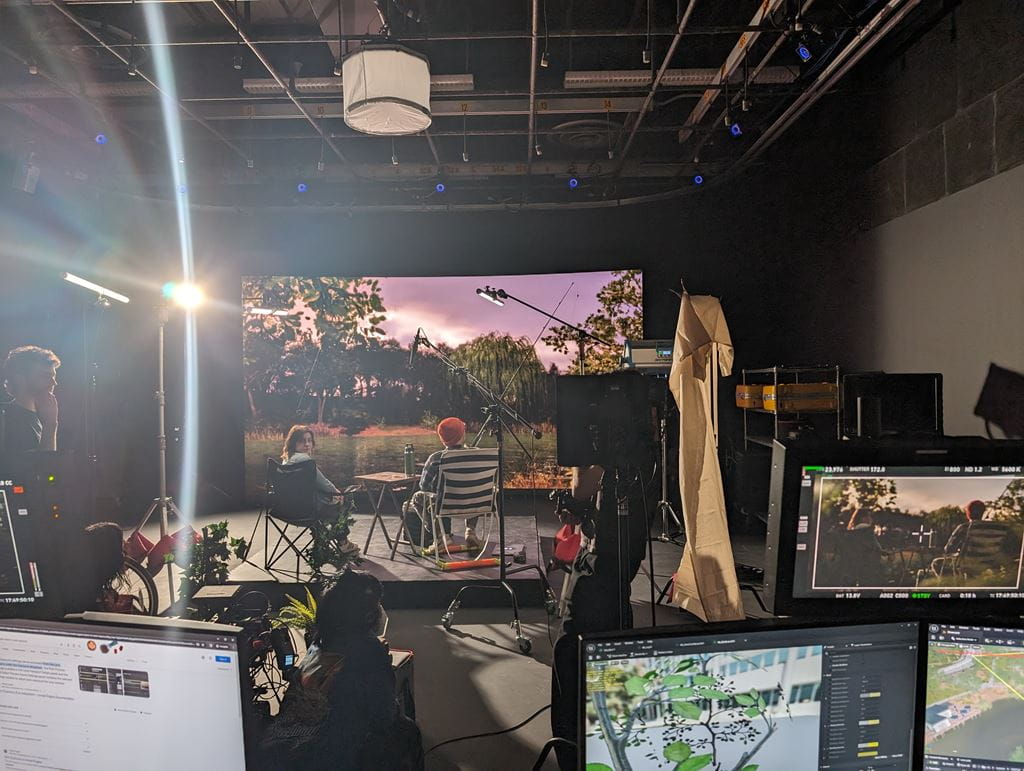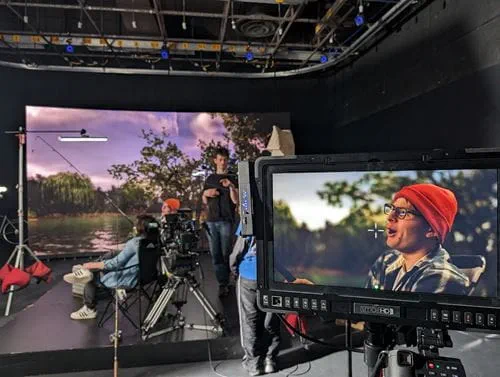
Students working with new LED volume, virtual production technology at Trafalgar campus
Sheridan students now enjoy access to a LED volume at Trafalgar Road Campus, adding a new chapter to the college's rich history as a pioneer and early adopter of emerging technologies in film and broadcast media.
LED volumes are used in virtual production (VP), which combines computer-generated imagery (CGI), game engine and virtual reality technology to enable new ways of creating film and television. Benefits of VP include minimizing time and costs involved with on-location shooting, reducing the need for post-production visual effects, enabling actors to interact with real-time environments instead of a green screen, enhancing lighting and more.
In 2019, Star Wars live-action series The Mandalorian became one of the first major productions to use VP, shooting a significant amount of its Season One footage on indoor virtual sets. More recently, shoots for Star Trek: Discovery and Star Trek: Strange New Worlds have been hosted in Toronto on the main virtual production stage of FX production house Pixomondo.
 Students from numerous programs throughout Sheridan's Faculty of Animation, Arts & Design (FAAD) and other Faculties will benefit from access to the college’s new LED volume, a system that generally consists of five main components: a large screen, camera tracking system, cinema camera, rendering engine and operator/editor workstations. Sheridan’s new LED volume features a 180-square-foot screen comprised of 66 LED cabinets and a Brompton LED processor; a 16-camera OptiTrack motion capture system synched with a CinePuck tracking tool; an Arri Alexa Mini cinema camera; a Lenovo P620 rendering engine with 2x A6000 graphic cards, 128 gigabytes of RAM and a ThreadRipper 5995WX CPU; and a mix of Lenovo P620 and HP Z6 workstations.
Students from numerous programs throughout Sheridan's Faculty of Animation, Arts & Design (FAAD) and other Faculties will benefit from access to the college’s new LED volume, a system that generally consists of five main components: a large screen, camera tracking system, cinema camera, rendering engine and operator/editor workstations. Sheridan’s new LED volume features a 180-square-foot screen comprised of 66 LED cabinets and a Brompton LED processor; a 16-camera OptiTrack motion capture system synched with a CinePuck tracking tool; an Arri Alexa Mini cinema camera; a Lenovo P620 rendering engine with 2x A6000 graphic cards, 128 gigabytes of RAM and a ThreadRipper 5995WX CPU; and a mix of Lenovo P620 and HP Z6 workstations.
The LED volume at Trafalgar Road Campus is modeled after a larger system installed several years ago in Sheridan's Screen Industries Research and Training (SIRT) Centre at Pinewood Toronto Studios, where Sheridan students, faculty and staff work with industry partners to advance digital image capture and creative processes. SIRT, an integral part of Generator at Sheridan, opened its VP Innovation Hub in April 2021 and launched a Virtual Production micro-credential program in 2022 in partnership with WarnerMedia Access Canada.
“It has been thrilling to watch this cutting-edge technology go full circle here at Sheridan, from helping test and advance it at SIRT to bringing it to the classroom at our Trafalgar Road Campus,” says Ann Callaghan, FAAD Associate Dean of Film, TV and Journalism. “It’s yet another testament to how our students, professors, researchers, administrators and alumni are so well-equipped to adapt and thrive in the constantly-evolving field of film and television.”
Students in Sheridan's Advanced Television and Film (ATVF) post-graduate certificate program — recently rebooted to teach all aspects of VP with specializations in art department, camera department or VP technician streams — will work extensively with the Trafalgar Road Campus LED volume on various projects. Sheridan's Honours Bachelor of Film and Television degree, Makeup for Media and Creative Arts diploma and Visual Effects graduate certificate programs have already used the LED volume as part of in-class learning.
“In addition to preparing our film and television students with VP skills and experience that will position them well for the future, on-campus access to an LED volume promises to have a powerful impact on so many of our other programs,” says Mark Jones, Dean of FAAD. “I am tremendously excited to see how students in animation, photography, musical theatre, game design, creative writing and other areas of study will benefit from the use of this technology.”
Learn more about how Sheridan’s ATVF graduate certificate program trains both recent graduates and experienced professionals for the future of broadcast and film.
Watch YourTV Halton's coverage of Sheridan's new virtual production studio and how it is already benefitting students across numerous programs.
Popular stories
- Sheridan statement regarding IRCC policy changes
- Sheridan celebrates the return of Netflix series “Blown Away”
- Sheridan College and SpacesShared partner on affordable housing option matching students with older adults
- How can educators use generative AI in the classroom?
- Sheridan welcomes Mary Vaughan as new Provost and Vice President Academic
Media Contact
Meagan Kashty
Manager, Communications and Public Relations





